http://www.dell.com/en-us/member/shop/dishonored-2-pc-gaming/apd/a8766277/gaming
Dishonored 2 for $19.99
Dishonored 2 for $19.99
Dishonored 2 Update – New Game Plus Mode
If you’ve wondered what it would be like to combine Empress Emily Kaldwin’s all-new abilities with Royal Protector Corvo Attano’s signature powers, you’ll soon have the opportunity to do just that. Next week Dishonored 2 will get its first free Game Update, which – along with various improvements based on player feedback – includes New Game Plus. With this new mode, you’ll be able to combine Emily’s Mesmerize with Corvo’s Devouring Swarm – or create any other custom combo of multiple powers that you can you imagine.

Unlocked once you complete Dishonored 2 with either Emily or Corvo, New Game Plus lets you begin anew with either character, but this time you’ll have access to the full suite of abilities from both of the game’s heroes. You’ll also start your new playthrough with all the Runes and Bonecharm Traits you’ve collected from your previous game, but you’ll be able to re-assign those Runes so you can choose the powers you want.
“Dishonored players have asked for it, so now New Game Plus is here for Dishonored 2,” says Creative Director Harvey Smith. “If you've ever wanted to make higher-powered characters, now's your chance. If you've wanted to play Emily Kaldwin with Possession or Devouring Swarm, or Corvo Attano with Domino, now you can. We've been having fun with it here at Arkane Studios, and we hope you will too.”
The first of two free updates, Game Update 1 releases today as a beta on PC, then will release in full for PC, Xbox One and PlayStation 4 on Monday, December 19.
Game Update 2 will arrive in January, and will include two new features: Mission Select and additional Custom Difficulty Settings, the latter of which allows you to further tailor Dishonored 2 to your playstyle and adjust the challenge based on a wide array of settings. We’ll have more info on Game Update 2 soon.
GAME UPDATE 1 RELEASE NOTES
New Features
Improved Features
- New Game Plus mode!
- New Quick-Access Wheel option for hiding/unhiding items
- Fixed Oraculum false-kill count in Royal Conservatory
- AI detection tweaks to clarify when players are detected or not
- AI locomotion improvement for running
- Fixed various Bonecharm effects (Strong Arm, Spiritual Pool, etc)
- Fixed a problem in slow-motion where some inputs were ignored
- Blood Thirst: various enhancement and fixes
- Killing an NPC with their own bullet is now more reliable
- Tweak for mana potion refill speed, depending on difficulty
- General performance and optimization improvements
- Fixed various game logic issues
- Fixed various User Interface issues
New Game + is literally decline.
New Game + is literally decline.
It doesn't really matter.
http://www.pcgamer.com/game-of-the-year-2016-dishonored-2/
game must really be horrible if pc gamer likes it

http://www.dell.com/en-us/member/shop/dishonored-2-pc-gaming/apd/a8766277/gaming
Dishonored 2 for $19.99
Anyone know if it's playable yet, or still a slideshow?















Why Dishonored 2 allows you to skip its finest content
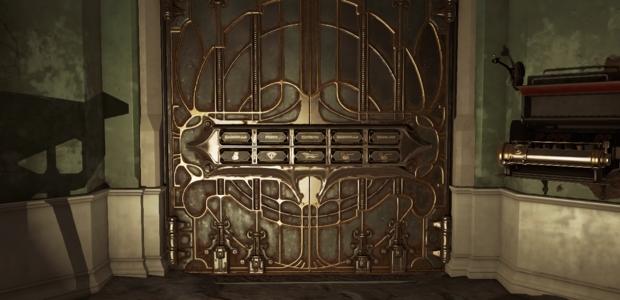
This is The Mechanic. Taking a dive into Dishonored 2 [official site] with Harvey Smith, it marks the first anniversary of the column. Holy heck! I hope you’ve been enjoying it. I want to thank everyone who’s read The Mechanic, and all the amazing designers it has given me the opportunity to speak to. Here’s to many more next year.
In the city of Karnaca is a district that lies under mounds of encroaching dust. Home to the labourers of the silver mines, Batista has been worked into exhaustion. Its people are spent and the mines so overexploited that dust from them has been billowing out and falling over the streets and squares, the heavy wind whipping it up into storms and engulfing entire buildings.
Dust District is one of Dishonored 2’s largest levels, a dense network of byways, apartments and compounds peopled by downtrodden miners and two warring factions. But you don’t need to play any of it. In fact, the entire level is designed around an idea that speaks to Dishonored’s deepest design principles. Because the Dust District is all about:
THE MECHANIC: Skipping stuff
(Light-ish spoilers for both the Dust District and subsequent level naturally follow.)
Your mission in the Dust District is to enter the house of a mining magnate called Aramis Stilton, which lies, apparently abandoned, behind unassailably high windbreaks. The entry to it stands just after the level’s beginning, but it’s locked behind a puzzle which you’re told is impossible to solve without a code. The puzzle is called the Jindosh Riddle, and getting its code means going deep into the district to take it, by force or otherwise, from one of two hostile factions.
The Howlers is a gang of thieves led by a boss called Paolo who’s rumoured to be able to survive being killed and wishes to wrest control of the city for the people. The Overseers are a fascistic hyper-orthodox religious sect who have heard of the Howlers’ use of black magic and aim to crush it. But you’re told at the mission’s outset that you can use their mutual enmity to your advantage. If you can present the body of the leader of one side to the leader of the other, you’ll be rewarded with access to the code.
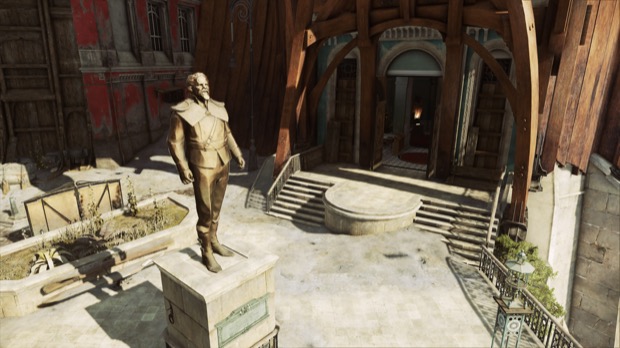
But the thing is, the puzzle is not unsolvable. With application of logic and maybe a lot of Post-It notes, you can divine the correct configuration of names and symbols from the riddle and open it. And if you do, there is no need at all to enter the Dust District. You needn’t negotiate its streets, apartments, rooftops and walkways; you can ignore their intricately laid out opportunities for concealment and murder and avoid penetrating the factions’ bases and kill and meet their respective leaders. You can disregard all the wads of dialogue, text and environmental detail placed for you to absorb. The next level is entirely open to you.
“Player, if you want to skip this, you can skip it,” creative director Harvey Smith tells me. “If you want to go fast, you can go fast. Slow if you want to go slow. We just believe a game is about play and playing with things.” His studio, Arkane, rose from the legacy of Looking Glass Technologies and its inception of the immersive sim, and Dishonored 2 is a worthy successor of the genre’s core values of giving players opportunity for self-expression.
“I feel like there’s a pretty big argument between developers who want you to see every single screen in the game and play through it one way because that’s the most high-drama, impactful way. And the only way you stop is if you die and then you reload and perfect what you’re doing and move on. On the other hand there are people who are like, no, there’s a big ecosystem and by definition you can’t see everything because you’re making decisions. Sometimes those are binary or mutually exclusive and by the end of the game you have your experience.”
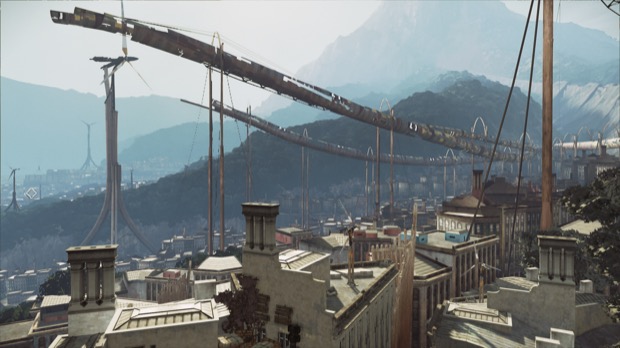
But even if the studio is philosophically founded on the principle that players won’t get to experience everything in the game, allowing them to skip an entire level was still a pretty big step. Smith says that though he and level design director Christophe Carrier were excited by the concept of the Jindosh Riddle, “other people on the project were shocked, like, ‘Really, we’re going to let people skip the mission?’” They therefore wanted to make it “really fucking hard, a legitimate difficult to solve puzzle,” so it has weight and a sense of reward. “We want to give something cool to the player that they haven’t seen before. We want them to feel challenged, to feel smart, and make the world seem interesting and cool and we think this is an edgy decision.”
Carrier went away to research puzzles worthy of the lock and came back with Einstein’s enigma, a series of facts about five different people with five different attributes. The number of variations is incredibly wide, but by following a set of clues the right attribute can be aligned with the right character and the puzzle can be solved. It provided an ideal template for a combination lock, its complexity such that players feel accomplishment that lives up to the name of the achievement you’re awarded for solving it: “Eureka”.
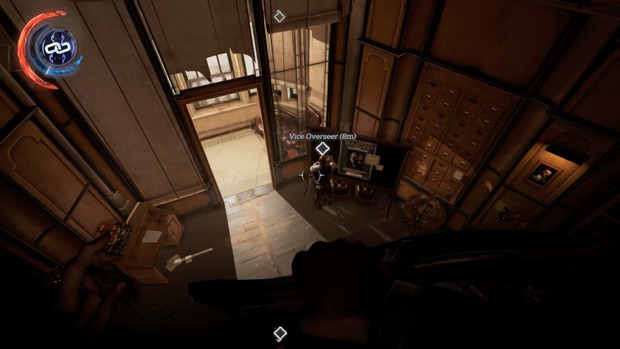
There was one more consideration, though, which was whether the game would be long enough for those players who walked up to the puzzle, solved it and moved to the next level. “Are we cheating the players? No, because if you want to go explore the rest of the Dust District you can. And there’s more than enough value in the game. I feel sometimes that we packed three games into one box.”
The Jindosh Riddle is only one of the expressions of skipping in Dust District, which was designed by level designer Steve Lee and architect Christophe Lefaure. Each level in the game was created by these pairings of someone who considers the game and its flow, and someone who considers their spaces as coherent wholes and how it will feel to stand in them. Lefaure is the one who thought about the impact dust storms would make on a place: of how the dust would pile greater on one side of a building than the other and blast the colour from hoardings, and how the rich would be able to afford to build wooden windbreaks to save their homes from being inundated. Lee is the one who began to think about what it’d mean, as a player, to be compelled to take the side of the fascists or the criminals to get what you want.
By taking the body of one side to the other faction, you’re given a pass by that faction to walk into their territory. You therefore no longer have to work out how to traverse it stealthily or violently. All the little details that allow you safe passage and all the guard positions and patrols, carefully planned to provide challenge, are by-the-by for as long as you’re holding the leader over your shoulder. But the result in play is that you feel rewarded rather than cheated of experiencing content you’ve paid for. A big part of the reason why is that you have choice over doing so: the moment you drop the body you’ll be attacked, so it’s on you. But you also feel you’ve earned it. Entering the Overseers’ outpost or the Howlers’ headquarters feels like a full level in itself. And then there are two alternative ways of getting the code: by following a series of clues to a note, or by capturing both leaders alive.
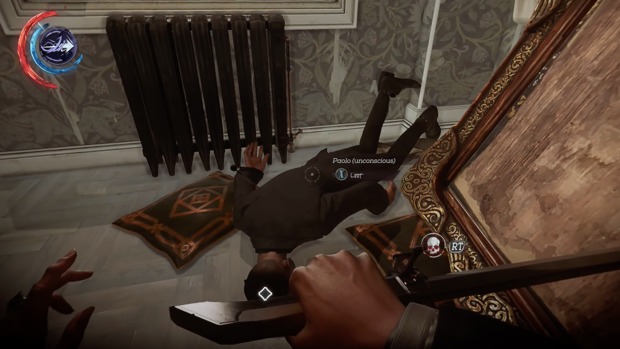
Dishonored 2 as a whole is designed to have swathes that can – and sometimes must – be skipped. At the very outset you’ll choose between two characters, Emily and Corvo. Each has specific dialogue and reactions by NPCs, and each has a different set of powers. “You are skipping massive amounts of content,” says Smith. “You’re never going to see Domino and Mesmerise and Rat Storm. Tonnes of work went into those things. You could build entire games around those powers.”
And then there’s the fact that only 1.5% of players on Steam have so far completed the game without using powers. And yet the entire game has been painstakingly tuned and tested to ensure it’s possible. You have to wonder what it means to a development team to know that players won’t experience so much of what it worked so hard on. Smith describes a “great and depressing moment” during playtesting for the first Dishonored in which a group was discussing with each other their experiences playing the High Overseer Campbell level, while the team listened in. One playtester was disappointed in the game because marketing materials he’d been presented with had said it was all about choice but he’d seen no alternative pathways to what he’d played. And then the other playtesters said how they’d performed other actions and seen entirely other things.
“We had a moment; we knew all this was possible. It’s there for us because we’ve played the game a hundred times, but it’s not there for them because they’ve played one or twice. How do we tell them, ‘Hey, you’re going left, by the way, you could have gone right!’ How do you do that elegantly? It’s still a challenge, and some would argue you should spent all your development budget on things that every player will see, because you’re throwing away part of your work if 98.5% of players never play no powers mode. It’s an arguable point. You have to be comfortable with it, it has to be part of your philosophy, I guess.”
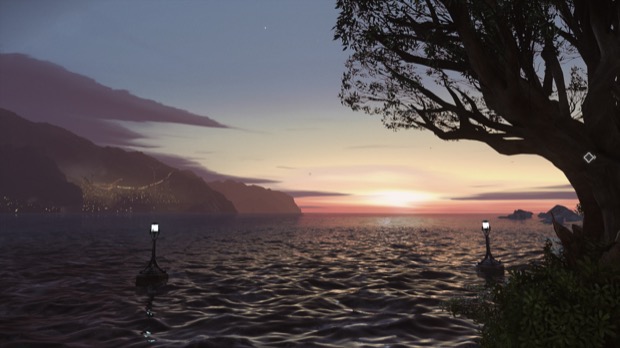
Dust District isn’t the only level with significant skippable material. In the next level, A Crack in the Slab, you can perform a logical but otherwise un-signposted action at a single critical moment that will transform the level and the game to come. If you miss it, you’ll have no idea these transformations exist. But for Smith it’s all justified when people tell him of their surprise when they experience them.
“It’s more like we’re rubbing our hands together in delight and we’re hoping that down the road people get that, you know? They have that magical moment where they play and maybe they have to play twice or talk to a friend, or maybe they just sense when they play that maybe it could be… It’s a little stress, like, ‘Ahh, should I do this or that?’ And then they see the results of what they’ve done and it’s wondrous. Games are one of those things that are still full of wonder.”


Man, the game tricks you in the tutorial, making you think it actually runs pretty good. And then the real deal starts.....
Refunded.
Agree with you, I think the game is best played AT LEAST in ghost mode, perhaps even without powers and/or without killing.*long rant*
Man, the game tricks you in the tutorial, making you think it actually runs pretty good. And then the real deal starts.....
Refunded.
Did you patch it?







